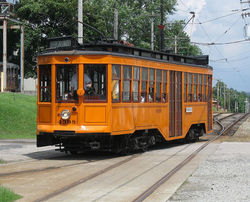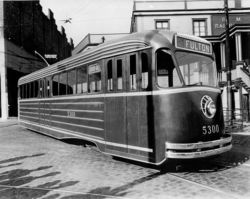1.0 About The ERPCC
About The Electric Railway Presidents Conference Committee
The intent underlying the following is not to repeat the ERPCC history so well documented in books by Schneider & Carlson, by Kashin & DeMoro, and as found in Wikipedia, the latter being of imperfect accuracy in places. The following will discuss the relationships between ERPCC, its child the Transit Research Corporation (TRC), and the builders and purchasers of vehicles that incorporated designs covered by ERPCC and, eventually, TRC patents.
Initially, work carried out under the banner of the ERPCC was funded by contributions from the Street Railway industry. Some patents were issued to principals of the ERPCC such as Clarence Hirshfeld, William Rossell, and Thomas Conway Jr. For example, patent 2010668 of August 6th, 1935 for a rail vehicle wheel tire was issued to Hirshfeld, who was assignor to Thomas Conway Jr and Charles Gordon, co-trustees for the Electric Railway Presidents Conference committee. However, TRC was intended to be the eventual holder of all the patents and most would be issued to individuals with TRC as assignee, and the first patent application was made on December 19, 1932 for an early resilient wheel design, with Emil H. Piron as the inventor and TRC as the assignee, having all rights of use and control. TRC was created for the purpose of carrying on improvements to the car design, to ensure that no patent infringements occurred, and to solicit new business. TRC's earnings were to come from royalty payments made by purchasers of vehicles employing designs covered by the patents. It was imperative for TRC to sell its services to as many clients as possible to ensure its economic survival.
What Is A PCC Car?
A number of sources including the late Seymour Kashin have quoted the TRC as stating that any rail vehicle incorporating a design that was based on a patent held by TRC would be considered a PCC car. The name "PCC Car" was never to the author's knowledge registered as a trademark. Because the first product produced was a streetcar, the use of "PCC car" has generally become to be considered as referring solely the modern streetcar that ERPCC and TRC developed. This truncated name for the proper designation of "PCC Streetcar" has led to confusion when streetcars in other places but North America are discussed. Additionally, the letters PCC are used by a number of other technical activities. For example, in the electronics field PCC is the Point of Common Coupling.
The goals of the ERPCC were to develop a streetcar that had a smooth, high level of performance on city streets, which was quiet, and which provided a higher level of passenger comfort with style, yet was affordable, this latter goal to be achieved through standardization, primarily of trucks and carbody elements, where TRC patents applied.
In order to get the "P.C.C. Standard Car" into production during1934 and 1935 meetings and communications were held between the ERPCC principals and The Equipment Advisory Committee to produce a specification that could be used for purchasing purposes. (this committee was composed of industry individuals) Purchasers could also issue their own purchasing specification, as in Philadelphia where the language "cars constructed by the St. Louis Car Company under terms of the agreement between St. Louis Car Co. and Raymond N. Baker dated June 1, 1940 and shall comply with all requirements of the Philadelphia Transportation Company's Specification 147-F-1 and TRC Specification dated April 1, 1941" assured that the cars were PCC streetcars.
The point of the above is to illustrate that a "PCC Streetcar" is one that complies with TRC's specifications for its streetcar product, and that there is an inherent difference technically between a "PCC car" and a "PCC streetcar". In North America the term "PCC car" is commonly understood to refer to a streetcar complying with TRC's streetcar specification. But there are a number of other rail cars that made use of one or more TRC patent and they rightly would also be called PCC cars, although that was not commonly done. These instances and similar situations in Europe will be discussed in following sections.

